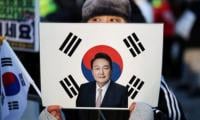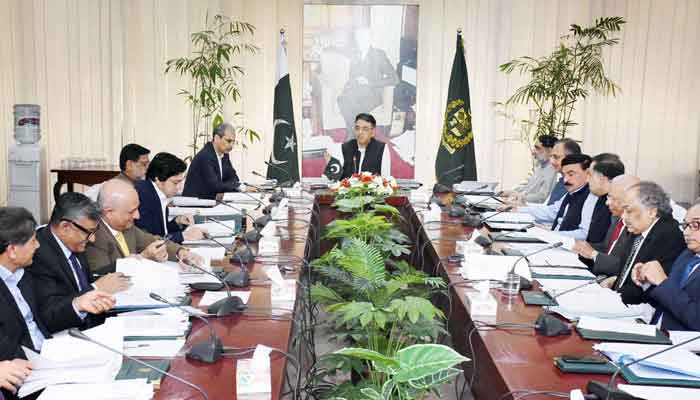Only options — go bankrupt or get IMF plan: Annual growth going to go down
the Asian Development Bank (ADB) has projected further deceleration of Pakistan’s GDP growth to 3.9 percent and rising inflation pressures on average at 7.5 percent for the ongoing financial year 2018-19.
ISLAMABAD: Finance Minister Asad Umar said on Wednesday that Gross Domestic Product (GDP) will be low this year and lower the next year. He said Pakistan has two options – either to go to the IMF or go bankrupt.
He said the country’s basic debts have reached alarmingly on such a high level that the country is near bankruptcy. Speaking in a special question and answer session on social media, he said: “You are going to the IMF with these massive debts in toe for a bailout. We have had to fill the big gap,” adding, “If you look at the numbers from the PML-N time, there was double-digit inflation during the PML-N time which we have thankfully not hit as yet.”
The finance minister said that unlike in the past, inflation has not hit double digits. “If you look at the past, inflation affected all stratas of society equally. In fact, the poor had higher levels of inflation affecting them. In our tenure this has seen a different trend with the poor feeling relatively less inflation as compared to higher income groups,” he claimed.
Umar admitted that the economy has slowed down which has resulted in low employment rate. “You’re saying all my policies are like Ishaq Dar, and Ishaq Dar says I’ve destroyed the economy! During his time, for the first time in Pakistan’s history our exports didn’t grow,” he said, “Dollar has climbed because of past economic policies that have led to such huge losses for us as a country.” He said, “It’s a basic demand and supply situation.”
Meanwhile, the Asian Development Bank (ADB) has projected further deceleration of Pakistan’s GDP growth to 3.9 percent and rising inflation pressures on average at 7.5 percent for the ongoing financial year 2018-19.
“The GDP growth is forecast to decelerate further to 3.9% in FY2019 as macroeconomic challenges continue and despite steps to tighten fiscal and monetary policies to rein in high and unsustainable twin deficits,” the Asian Development Outlook (ADO) 2019 released by ADB here on Wednesday. The last PML-N-led regime had projected GDP growth rate at 6.2 percent.
To meet its large financing needs, the ADO 2019 states that the government is discussing a macroeconomic stabilisation programme with the International Monetary Fund (IMF) in addition to arranging financial assistance and oil credit facilities from bilateral sources.
Continued fiscal consolidation in FY2020 will keep growth subdued at 3.6%, it further states. The supply side is already showing signs of slowdown.
Agriculture is expected to underperform the 3.8% growth target for FY2019 after water shortages struck as wet season crops were being sown. Large-scale manufacturing reversed 6.6% growth in the first half of FY2018 to decline by 1.5% in the same period of FY2019 as domestic demand contracted and rising world prices crimped demand for raw materials.
Contraction hit all key categories, including a 0.2% decline in textiles. A slowdown in agriculture and industry as domestic demand shrinks will keep growth in services subdued. A government structural reform package announced in January 2019 is expected to support agriculture, facilitate new business openings, and continue to expand capacity in some industries to the forecast horizon.
“Stabilisation policies and rising inflation are likely to contain growth in private consumption and investment, while public sector development spending has already slackened,” it stated.
With exchange rate flexibility and declining imports, net exports are expected to contribute to growth. Average inflation accelerated sharply from 3.8% in the first 8 months of FY2018 to 6.5% in the same period of FY2019, led by a surge in nonfood inflation to 9.1% that reflected currency depreciation and a significant increase in gas tariffs for consumers and industry in the first half. Food inflation remains relatively moderate at 2.6% thanks to sufficient stocks of food staples. In response to intensifying inflationary pressures, the central bank gradually raised, in four rounds from July 2018 to January 2019, its policy rate by 375 basis points to 10.25%.
“Despite tighter monetary policy and lower international oil prices, inflation is expected to rise sharply to average 7.5% in FY2019, driven up by continued heavy government borrowing from the central bank, hikes to domestic gas and electricity tariffs, further increases in regulatory duties on luxury imports, and the lagged impact of currency depreciation by more than 10.7% since July 2018,” it further stated.
Inflation will remain elevated at 7.0% in FY2020. A supplementary consolidated government budget for FY2019, adopted in September 2018, envisages a decline in the budget deficit to 5.1% of GDP in FY2019, mainly by cutting the development expenditure excluding CPEC projects, but it also included measures to enhance revenue and extend relief to the poor.
Growth in tax collection weakened from a robust 16.4% in the first half of FY2018 to only 2.7% a year later. The Federal Board of Revenue (FBR) targets tax collection equal to only 11.6% of GDP in FY2019, taking into account reduced sales taxes on major petroleum products, drag on the collection of withholding tax from contracts, contraction in general sales tax revenue as imports slow, and the overall slowdown in the economy.
Including nontax revenue, total revenue declined by nearly 2.4% in the first half of FY2019. Budget expenditure increased by 5.5% in the first half of FY2019 over the same period a year earlier as current spending rose for interest payments and defense. Lower revenue collection and higher current expenditure pushed the budget deficit from the equivalent of 2.3% of GDP in the first half of FY2018 to 2.7% a year later.
This situation will make it a challenge for the government to achieve the reduction in the budget deficit it targets for FY2019. A second supplementary budget, adopted on 6 March 2019 without information on the projected deficit, focuses on an economic reform package envisaging incentives and measures to encourage investment and exports, enhance the ease of doing business, and strengthen export-oriented activities. In the first 8 months of FY2019, the government borrowed more from the central bank and less from commercial banks, freeing up liquidity with which commercial banks boosted credit to the private sector by 18.9% over the same period of FY2018.
This sharply increased net domestic assets and nearly doubled broad money growth to 2.8%. The current account deficit is expected to ease in FY2019 but will remain high at the equivalent of 5.0% of GDP because of the large trade deficit. It will narrow further to 3.0% in FY2020 with easing macroeconomic pressures on the external accounts.
Export growth plunged from double digits in the first 7 months of FY2018 to 1.6% in the same period of FY2019. It is expected, however, to strengthen in the remaining months of this fiscal year and further in FY2020 as the lagged impact of currency depreciation kicks in, along with the incentive package for export-oriented industries announced in January 2019. Imports fell by 0.8% in the first 7 months of FY2019 from the same period of FY2018, with imports other than oil 5.7% lower because of slower domestic economic activity, currency depreciation, and an increase in import duties for nonessential items. Remittances are expected to revive—having already risen by 10% in the first 7 months of FY2019 over the same period of FY2018—as the Pakistan rupee depreciate further, economic activity in the Middle-eastern oil exporting countries (major destination of Pakistani migrants) holds broadly steady, and the government takes measures to facilitate remittances through official channels.
The government’s diaspora bonds—issued in January 2019 with terms of 3 and 5 years and an attractive return of over 6%—aim to tap resources from overseas Pakistanis. Inflows that do not incur debt, such as foreign direct investment, are expected to be lower in FY2019 as several CPEC energy projects are near completion.
Financing a high current account deficit in FY2019 will require substantial borrowing, as in the first 7 months of the year, and use much of the bilateral lending support announced in the early months of 2019 to finance the deficit in the balance of payments. Foreign exchange reserves, depleted to $8.1 billion in February 2019, will likely remain stressed at the end of FY2019, it concluded.
-
 Prince Harry’s Mental Health Ends Up At Stake As Meghan Moves Him To 'second Fiddle'
Prince Harry’s Mental Health Ends Up At Stake As Meghan Moves Him To 'second Fiddle' -
 Bradley Cooper On Who His Mother Thinks Is The World’s Best Actor
Bradley Cooper On Who His Mother Thinks Is The World’s Best Actor -
 Meghan Markle Offers Glimpse Into Intimate Dance Moment With Harry Amid Split Rumors
Meghan Markle Offers Glimpse Into Intimate Dance Moment With Harry Amid Split Rumors -
 Jon Bon Jovi Joins The Viral 2016 Throwback Trend With Nostalgic Photos
Jon Bon Jovi Joins The Viral 2016 Throwback Trend With Nostalgic Photos -
 Kate Middleton Hailed For Her Lack Of ‘obligation’ As Well As Altruistic, Selfless Qualities
Kate Middleton Hailed For Her Lack Of ‘obligation’ As Well As Altruistic, Selfless Qualities -
 Jason Momoa Says Being With Beau Adria Arjona Feels 'perfect'
Jason Momoa Says Being With Beau Adria Arjona Feels 'perfect' -
 Idris Elba Says One Mix-up Nearly Cost Him A Knighthood From King Charles
Idris Elba Says One Mix-up Nearly Cost Him A Knighthood From King Charles -
 Andrew Mountbatten Windsor Incurs Anger Of Biggest Royal
Andrew Mountbatten Windsor Incurs Anger Of Biggest Royal -
 Megan Fox, Machine Gun Kelly's Relationship 'is Just About Co-parenting'
Megan Fox, Machine Gun Kelly's Relationship 'is Just About Co-parenting' -
 Prince Harry, Meghan Markle Warned They Can’t Fool Brits Because It Won’t Land
Prince Harry, Meghan Markle Warned They Can’t Fool Brits Because It Won’t Land -
 South Korea’s Ex-president Yoon Suk Yeol, Sentenced To 5 Years In Prison: Key Details Explained
South Korea’s Ex-president Yoon Suk Yeol, Sentenced To 5 Years In Prison: Key Details Explained -
 Princess Beatrice Is ‘terrified’ Of Mom Fergie: ‘She’s Begging Her To Not Destroy Her Future’
Princess Beatrice Is ‘terrified’ Of Mom Fergie: ‘She’s Begging Her To Not Destroy Her Future’ -
 Harry Styles’ New Album Earns Subtle Nod From Zoe Kravitz’s Dad
Harry Styles’ New Album Earns Subtle Nod From Zoe Kravitz’s Dad -
 Ari Emanuel Makes A Decision Regarding His Memoir Alongside Prince Harry’s Ghostwriter
Ari Emanuel Makes A Decision Regarding His Memoir Alongside Prince Harry’s Ghostwriter -
 Buckingham Palace Gives The Spotlight To The Duke And Duchess Of Edinburgh: Video
Buckingham Palace Gives The Spotlight To The Duke And Duchess Of Edinburgh: Video -
 Eva Mendes Revisits Year She Hid Pregnancy
Eva Mendes Revisits Year She Hid Pregnancy




